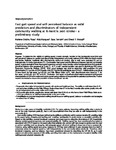Fast gait speed and self-perceived balance as valid predictors and discriminators of independent community walking at 6 months post-stroke – a preliminary study
| dc.contributor.author | Rosa, MC | |
| dc.contributor.author | Marques, A | |
| dc.contributor.author | Demain, Sara | |
| dc.contributor.author | Metcalf, CD | |
| dc.date.accessioned | 2019-06-06T16:11:07Z | |
| dc.date.available | 2019-06-06T16:11:07Z | |
| dc.date.issued | 2015-01-16 | |
| dc.identifier.issn | 0963-8288 | |
| dc.identifier.issn | 1464-5165 | |
| dc.identifier.uri | http://hdl.handle.net/10026.1/14263 | |
| dc.description.abstract |
PURPOSE: To determine the validity of walking speed, muscle strength, function of the hemiparetic lower limb and self-perceived balance to predict and discriminate independent community walkers (ICW) within the first 6 months post-stroke. METHODS: Inpatients with a first ischemic stroke (<3 months), able to walk, were evaluated (T0) and re-evaluated after 6 months post-stroke (T1). Comfortable, fast speed and the difference between fast and comfortable speed, muscle strength of knee flexors and extensors, sensory-motor function of the hemiparetic lower limb and self-perceived balance were assessed at T0 and T1. At T1, a self-reported question was used to discriminate ICW versus Dependent Community Walkers (DCW). ROC curve analysis was used to determine valid predictive (T0) and discriminative (T1) cut-offs of ICW. RESULTS: Only 25.7% of the 35 participants were ICW at T1. Valid predictive cut-offs at T0 were found for fast speed (≥0.42 m/s) and Falls Efficacy Scale (<57). Valid discriminators were found at T1 for fast speed (>0.84 m/s) and FES (<18.50). CONCLUSION: Fast speed and self-perceived balance appear to be important characteristics of ICW at 6 months and may be useful early predictors of the potential for patients to achieve this. Further research is needed to ensure the precision of these functional cut-offs. | |
| dc.format.extent | 129-134 | |
| dc.format.medium | Print-Electronic | |
| dc.language | en | |
| dc.language.iso | eng | |
| dc.publisher | Informa UK Limited | |
| dc.subject | Balance | |
| dc.subject | community | |
| dc.subject | gait | |
| dc.subject | stroke | |
| dc.subject | walking | |
| dc.subject | Adult | |
| dc.subject | Aged | |
| dc.subject | Aged, 80 and over | |
| dc.subject | Exercise Test | |
| dc.subject | Female | |
| dc.subject | Gait | |
| dc.subject | Humans | |
| dc.subject | Male | |
| dc.subject | Middle Aged | |
| dc.subject | Muscle Strength | |
| dc.subject | Perception | |
| dc.subject | Postural Balance | |
| dc.subject | Prognosis | |
| dc.subject | Stroke Rehabilitation | |
| dc.subject | Walking | |
| dc.title | Fast gait speed and self-perceived balance as valid predictors and discriminators of independent community walking at 6 months post-stroke – a preliminary study | |
| dc.type | journal-article | |
| dc.type | Journal Article | |
| dc.type | Research Support, Non-U.S. Gov't | |
| plymouth.author-url | https://www.ncbi.nlm.nih.gov/pubmed/24754638 | |
| plymouth.issue | 2 | |
| plymouth.volume | 37 | |
| plymouth.publication-status | Published | |
| plymouth.journal | Disability and Rehabilitation | |
| dc.identifier.doi | 10.3109/09638288.2014.911969 | |
| plymouth.organisational-group | /Plymouth | |
| plymouth.organisational-group | /Plymouth/Faculty of Health | |
| plymouth.organisational-group | /Plymouth/Users by role | |
| dc.publisher.place | England | |
| dc.identifier.eissn | 1464-5165 | |
| dc.rights.embargoperiod | Not known | |
| rioxxterms.versionofrecord | 10.3109/09638288.2014.911969 | |
| rioxxterms.licenseref.uri | http://www.rioxx.net/licenses/all-rights-reserved | |
| rioxxterms.type | Journal Article/Review |


